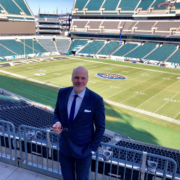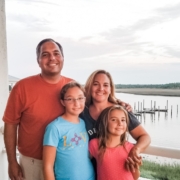One family’s experience with stroke and beyond
It was an ordinary workday in August 2021 when Helen Stevenson experienced a cerebrovascular event that would change everything for her and her husband Mike.
Helen, only 55 years old then, was at work at the time. She got up to walk across the office and felt a sharp pain in her head. When she returned to her chair, she knew something was awry, but she couldn’t figure out what. A colleague asked her something that didn’t make any sense to her, and Helen’s responses were even more puzzling. That’s when it became clear to everyone: Helen was having a stroke. Because Helen got to the local hospital so quickly, doctors were able to administer clot-busting medicine that improved, but did not fully reverse, her symptoms.
Unfortunately, damage had been done.
“At the hospital, I was aware something was going on, but I had no idea what it was,” Helen said, looking back. “I was very confused, and I couldn’t tell you the months and year or the weeks.”
She also now had something called global aphasia, which causes impairment in speaking, understanding, reading, and writing. Another issue for Helen was her vision: During the incident at work, she kept telling people, “My lights are against me,” which was her way of saying that her vision was changed. The blurred and double vision lingered for a day or two but ultimately subsided.
The hospital conducted routine blood work and determined Helen was in good health. They sent her home after two nights.
Things became less clear after that.
A difficult road
Helen’s experiences of stroke and stroke recovery have been complicated, to say the least. Helen’s stroke kicked off a journey for the Stevensons that has been at times frightening, frustrating, exhilarating, and hopeful. Nearly three years later, Helen is still dealing with language changes and other effects of the stroke.
Thankfully, mercifully, Helen and Mike have vowed to work together to carve out a new life.
“We’re doing the best we can,” said Mike, who is also 58. “Helen struggles with some things. We’re just not going to be too upset about it because it could be a lot worse.”
Helen’s story highlights the fact that although stroke diagnosis and intervention have advanced rapidly in recent years, no two strokes are the same. It also communicates some of the remaining practical challenges in providing stroke care in the early days and beyond.
First, Helen’s brain is organized differently than most people’s. Studies have shown that for 85 to 90 percent of people, language skills are located in the left hemisphere of the brain. This number is even higher for right-handed people, whose left hemispheres house language 90 to 95 percent of the time. Only a small section of the population have language-dominant right hemispheres, and most of those people are left-handed.
Helen is left-handed.
Given that Helen’s first stroke symptoms were changes in her ability to speak and understand, it was initially thought that Helen’s stroke was occurring in the left middle cerebral artery, a large artery on the left side of her brain. Instead, Helen is one of those rare left-handed people whose right hemisphere controls language as well as many visual and spatial tasks. This created some errors in communication around her care, with even some of her medical records noting the wrong artery for her stroke.
Helen’s stroke also has no known explanation. Doctors can identify the cause of a stroke, such as loose plaque traveling from the heart or other large artery, about 60 to 70 percent of the time. This can allow more focused treatments for preventing future strokes. The other 30 to 40 percent of strokes remain unexplained, or “cryptogenic.” Helen’s stroke is one of those 30 to 40 percent, leaving unanswered questions about treatment. This also created a frightening uncertainty for the Stevensons: If Helen’s stroke could be explained, how could they be confident it wouldn’t happen again?
The TIAs
In the early days, Helen could not be left alone. She needed help with most everything, including cooking and taking care of her medicines. She certainly could not drive, and with her aphasia, she could not call 911 if her stroke symptoms came back. Either Mike or Helen’s sister stayed with her at all times because of this, which was a stark change from Helen’s pre-stroke capabilities as a bookkeeper for large shipping companies and school systems at different points in her career.
However, Helen dedicated herself to rehabilitation efforts wholeheartedly. She was not referred to inpatient rehabilitation from the hospital, which affected her early course, but she engaged in intensive regular speech therapy sessions longer than her insurance company would allow. This was expensive and tiring, but helpful. She went on daily walks with Mike and relearned more and more daily skills. Her aphasia was improving gradually.
Then, in April 2022, Helen woke up on a Saturday and couldn’t move her arm.
It turned out Helen was experiencing a small event known as Transient Ischemic Attack (TIA). Later, she learned she had experienced two other TIAs that same week. Mike rushed Helen to the hospital again. This time she was monitored for five nights and released. Because TIA symptoms usually resolve on their own, there wasn’t much doctors could do to help Helen.
Helen and Mike say that, from their perspective, Helen’s TIAs did not follow the rules. They do not believe that Helen’s TIA symptoms went away as they should have, instead, leaving her with worse symptoms. This was immensely frustrating and discouraging to the Stevensons. It also was terrifying. Their experience highlights questions present even in the medical community about TIAs. As medical understanding of the mechanics of stroke has matured, so have medical definitions. Older definitions of TIA stated that symptoms should resolve within 24 hours, but newer evidence suggests that many patients actually show new stroke damage on imaging if their symptoms last even more than about 10 minutes.
MRI in these new transient events can also help identify the source of the problem, further guiding treatment at a deeper level. (Also, see this article.) This focus on brain tissue damage rather than how long symptoms last redefined many TIAs as new ischemic strokes, raising questions about how doctors should intervene in these situations and changing the guidelines around them.
Other barriers are practical ones. MRI machines are not used just for brain imaging, and oftentimes they are booked well in advance with patients who have many other kinds of illnesses and injuries. Because of this, MRI machines are often not available quickly enough to run the time-sensitive studies that can help tell the difference between a true TIA and a new ischemic stroke in any given patient. (Also, see this article.) This means that specific MRI studies can help identify the difference between TIA and new stroke in many patients, but few patients actually receive them.
For Helen, recovery has been slow since these new events. She still can’t drive, and she’s in the bottom fifth percentile for some executive functions.
“I can only do one thing at a time since the TIAs,” she said.
To say Helen and Mike have been frustrated by the impact of the TIAs would be a major understatement. What’s more, Mike noted it was difficult to get answers from doctors about what was happening—beyond the fact that they believed Helen had not experienced another full-fledged stroke.
“Communication is key,” said Mike, who is a school principal. “Some of the doctors on our journey really didn’t give us the attention we would have liked.”
Living with a new reality
Eventually, Helen and Mike connected with new doctors who communicated with them in a way that made them feel seen. These doctors listened. These doctors empathized. These doctors made the couple feel like they weren’t in this alone.
“It brought an intangible sense of peace and comfort during a very tumultuous time,” Mike said. “When you are talking with someone, whether it’s the patient or caregiver, there are intangible factors such as empathy, patience, explaining, and checking for understanding. Those factors really make a difference.”
Mike and Helen have made several life changes, too.
First, they sold their house and moved closer to downtown because Helen can’t drive. Second, they connected with a new doctor—a neuropsychologist named Dr. Amelia Anderson-Mooney—who has helped the couple cope with the day-to-day realities of life after stroke.
Helen isn’t actively participating in rehab these days, but she is trying her best to keep her brain active. She walks every day. She gardens.
There are still side effects.
“I still catch myself saying the wrong things,” Helen explains. “It’s almost like, in my brain things are opposite. If you say, ‘Black,’ I might say, ‘White.’ I know I call males females and females males. I get tired easily. I can’t cook.”
Helen adds that she has come to accept that this might be as good as things get. “I’ve learned to cope,” she said.
Mike has learned to cope, as well, by perspective-taking and being thankful for the present.
“We have a very deep faith, and we know the range of impact after a stroke is great,” he said. “[Helen is] not bed ridden and [I’m] not changing diapers.”
Mike has taken over cooking and shopping duties. The duo still engages in many of the activities they love—they go on walks, they entertain guests, they go to church. Helen has instructed friends not to correct her language struggles unless she asks them to.
Together, the couple is finding a way forward.
“I’m at a loss sometimes of what to do and how to do it, but we usually figure it out,” Mike said. “This is our reality after my wife’s stroke. We’re committed to making the best of it, for each other.”
Helen and Mike Stevenson gave BrainWise permission to share details of their journey in this story. The rest of the piece has been factchecked. For more about that process, click here.









